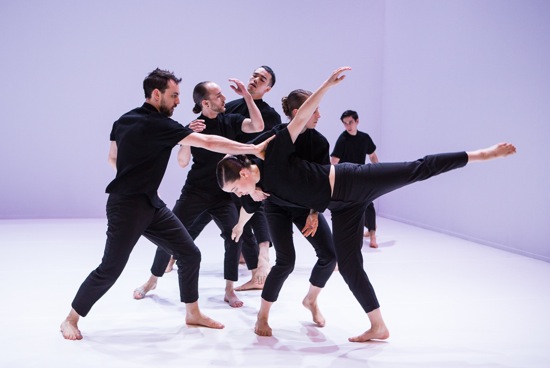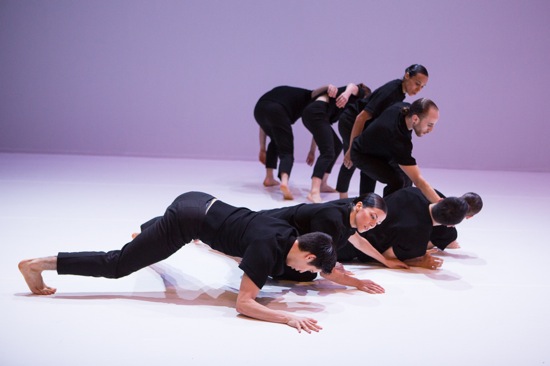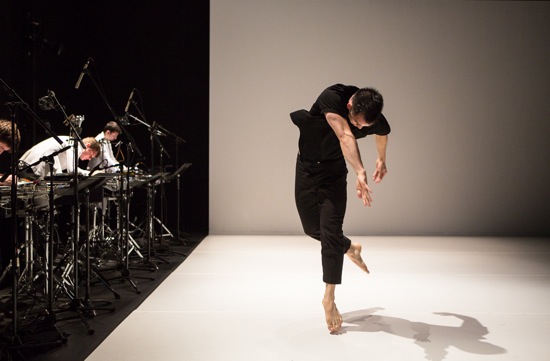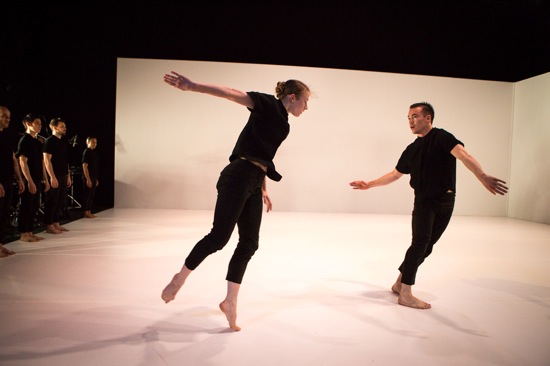Choreographer Brian Brooks and composer Jerome Begin collaborate at The Kitchen.

Brian Brooks’s Wilderness. (Leg stretched): Carlye Eckert; (L to R): Nate Buchsbaum, Matthew Albert, David Norsworthy, Ingrid Kapteyn, Daniel Ching. Photo: Yi-Chun Wu
I don’t know why Brian Brooks titled his fascinating new work Wilderness, since the word conveys that there’s no man-made order involved, while his “wilderness” is precisely structured with a considerable amount of over-and-over repetition by eight black-clad dancers (costumes by Karen Young). On a white floor, with two white walls set in a right angle at the back and along one side of The Kitchen, their patterns could be calligraphy on a sheet of paper.
The members of Brian Brooks Moving Company are not alone in The Kitchen during this second presentation by the American Dance Institute. The four members of Sandbox Percussion (Jonathan Allen, Victor Caccese, Ian Rosenblum, and Terry Sweeney) wear white suits and play Jerome Begin’s score on gleaming silver drum sets and other percussion instruments aligned along the left side of the performing area. Lighting designer Joe Levasseur has not only positioned a sidelight high above each man, but also set two differently focused ones behind each.
As Wilderness progresses, I begin to divine a kind of landscape—a field in which the same wild flowers or shrubs grow, rooted but susceptible to re-patterning by wind or other forces. Levasseur’s lighting changes it. So does Begin’s music, which is rich in changing textures over its underlying, mostly unheard pulse. Sometimes, you hear what sounds like a falling-downstairs progression along the drums, sometimes, there’s a veritable storm of percussion. At one point, Caccese begins steadily ripping a sheet of paper into strips; Rosenbaum slashes his paper with a knife. More nervously abrasive is the men’s amplifyied scribbling on paper. At least one of them has tiny chimes to play, and once, when I look over at the group, thinking I heard a violin, they are stroking slender vertical wands against I don’t know what surface. Live electronic processing also figures.
Whatever the four are playing, the sounds stop dead for a few seconds of silence at the end of each section of dancing.

Brian Brooks’s Wilderness. (Identifiable L to R counterclockwise): Daniel Ching and Cara Seymour; ( standing): Matthew Albert and Marielis Garcia. Photo: Yi-Chun Wu
Given the amount of repetition and variation, I watch the choreography as something that changes within its parts but not in its overall atmosphere. Smoothly and almost ceaselessly, the seven slip in and out of formations, falling, catching, supporting, lifting; at time they’re working in pairs, sometimes in trios. But always you’re aware of their awareness of one another. A person just risen turns to see another tilting and steps in for the catch. They may suspend a step or sway, as if waiting to find the best direction in which to step. Several times they start to form a line, but it dissolves almost before completion. Their bodies bend, arch, lean, and sway in that unseen wind, whether an inner one or the weather of the moment. Because the intricate, swirling connections don’t seems to lead them anywhere; you can either become impatient, wondering what they want, or will yourself to be ensnared by the tides of movement.
But this section leads to something quite different: a single maneuver—a task, if you will—is repeated over and over, turned in different directions, and moved gradually over the floor. It begins when Cara Seymour sits on David Norsworthy, who’s curled up on his side. When she rises he nudges her behind the knees; without looking down at him, she sits again; he rolls to push her back into standing position. She takes a few steps, and he (without ever rising) moves in to make himself into a seat for her again. He rolls, she rises, he nudges, she sits. . . . Despite the implicit violence of this ongoing partnership, Seymour remains calm, staring into space, accepting the ups and downs that Norsworthy is inducing, and he— neither tender nor punitive—focuses on his task and her needs.

David Norsworthy dancing and (L to R) musicians Jonathan Allen (mostly hidden, Terry Sweeney, and Ian Rosenbaum. Photo: Yi-Chun Wu
It’s while the musicians are working with the sheets of paper that Norsworthy performs a remarkable solo, mostly downstage quite near them. Throughout it, he’s both strong and unstable, even though his knees are mostly bent and his feet planted firmly. He moves smoothly and swiftly, but his limbs, his head, or different parts of his body seem constantly to pull him into contrary directions—sometimes several at the same time. He wheels around, ducking under or stepping over things we can’t see. You wonder if he can twist himself in such a way that untwisting will be impossible, but no. The process ends when the others rise from where they’ve been lying on the floor and cage him—absorb him—into a cluster that scuttles along sideways into brighter light and deeper bass tones.
Early on, the dancers remove their black jackets and perform only in their tight pants and short-sleeved shirts. At some point they pick the jackets up from where they’ve dropped them at the front of the stage and put them on again, but they shuck them during the next sequence. Lying down, they heave themselves into rolling by pushing their hips off the floor and rotating to thud heavily down again. The musicians accompany these awkward, arduous maneuvers with heavy beats, and while the dancers don’t look at if they’re trying to shuck the jackets the way snakes wiggle out of their skins, the results are the same.

Ingrid Kapteyn and David Norsworthy. Lined up at side (L to R): Matthew Albert, Daniel Ching, Nate Buchsbaum, Marielis Garcia. Photo: Yi-Chun Wu
Whether it’s snakes or tides or echoes or gusts of wind (or none of these) that Brooks is thinking of, a final choreographic device evokes serpentine movement, while also giving us the opportunity to focus briefly on each dancer, even though Matthew Albert, Nate Buchsbaum, and Marielis Garcia have risen to prominence at one point or another. Now near the end of Wilderness, all seven stand in a line from the front to the back of the stage, and Ingrid Kapteyn, who heads the line, begins to dance alone, scooping and turning, and whipping her legs around. As she travels a little away from the line, the others step to stay behind her. However, they don’t appear to anticipate her moves efficiently, so that some at the tail end may, for example, be already moving back to the left with her, while others are still moving to the right. Everyone (that includes Carlye Eckert and Daniel Ching) gets a turn to dance alone at the front of this undulating line; if you haven’t focused for more than a few seconds on some of the dancers, Brooks makes sure you understand how gifted they all are.
What is wilderness and how does it relate to wildness? To nature’s sometimes invisible order? Brooks’s impeccable piece makes me think of wild, foraged-for food imaginatively arranged on a white plate, still smelling of ocean and forest.
